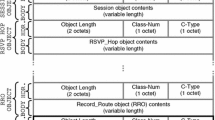Abstract
In this paper, we present a new Quality of Service (QoS) routing model for Differentiated Services (Diffserv) over Multiprotocol Label Switching (MPLS) networks. We use a pre-established multi-path model in which several MPLS label switching paths (LSPs) are established between each ingress-egress router pair in advance. Ingress routers perform per-request admission control and bulk-type resource reservation based on the resource availability on the associated LSPs. We use a utilization-based dynamic load balancing scheme to increase resource utilization across LSPs. The proposed model increases signaling and state scalability in the network core. It also provides hard QoS guarantees and minimizes admission control time. The experimental results verify the achievements of our model under various network topologies and traffic conditions.
Similar content being viewed by others
References
Chen, S., & Nahrstedt, K. (1998). An overview of quality-of-service routing for the next generation high-speed networks: problems and solutions. IEEE Network Magazine, 12, 64–79.
Apostolopoulos, G., et al. (1999). QoS routing mechanisms and OSPF extensions. RFC 2676, Internet Engineering Task Force.
Nelakuditi, S., et al. (2002). Adaptive proportional routing: a localized QoS routing approach. IEEE/ACM Transactions on Networking, 10(6), 790–804.
Mantar, H. A., et al. (2004). A scalable model for inter-bandwidth broker resource reservation and provisioning. IEEE Journal on Selected Areas in Communications, 22(10), 2019–2034. Special issue on design, implementation and analysis of communication protocol.
Elwalid, A., et al. (2001). MATE: MPLS adaptive traffic engineering. In Proceedings of IEEE INFOCOM (pp. 1300–1309). New York: IEEE Press.
Zhang, Z.-L., et al. (2000). Decoupling QoS control from core routers: a novel bandwidth broker architecture for scalable support of guaranteed services. IEEE/ACM Transactions on Networking, 8(4), 429–442.
Mantar, H. A., et al. (2006). An intra-domain resource management model for diffserv networks. Journal of High Speed Networks, 15, 185–205.
Nichols, K., Jacobson, V., & Zhang, L. (1999). A two-bit differentiated services architecture for the Internet. RFC 2638, Internet Engineering Task Force.
Mantar, H. A. (2006). A quantitative QoS routing model for Diffserv aware MPLS networks. In 6th IEEE international workshop on IP operations and management (pp. 61–71). Dublin, Ireland. Berlin: Springer.
Black, S., et al. (1998). An architecture for differentiated services. RFC2475, Internet Engineering Task Force.
Rosen, E. C., Viswanathan, A., & Callon, R. (2001). Multiprotocol label switching architecture. RFC 3031, Internet Engineering Task Force.
Jacobson, V., Nichols, K., & Poduri, K. (1999). An expedited forwarding PHB. RFC 2598, Internet Engineering Task Force.
Heinanen, J., et al. (1999). Assured forwarding PHB group. RFC 2597, Internet Engineering Task Force.
Christin, N., Liebeherr, J., & Abdelzaher, T. F. (2002). A quantitative assured forwarding service. In Proceedings of IEEE INFOCOM (pp. 864–873). New York: IEEE Press.
Wang, S., et al. (2004). Providing absolute differentiated services for real-time applications in static-priority scheduling networks. IEEE/ACM Transactions on Networking, 12(2), 326–339.
Nichols, K., & Carpenter, B. (2001). Definition of differentiated services per domain behaviors and rules for their specification. RFC 3086, Internet Engineering Task Force.
Hwang, J., et al. (2004). An implementation study of a dynamic inter-domain bandwidth management platform in DiffServ networks. In Proceedings of 9th IEEE/IFIP network operations and management symposium (pp. 321–334). Seoul, Korea. New York: IEEE Press.
Hopps, C. E. (2000). Analysis of an equal-cost multi-path algorithm. RFC 2992, Internet Engineering Task Force.
Bertsekas, D., & Gallager, R. (1992). Data networks (2nd ed.). Englewood Cliffs: Prentice-Hall.
Paxson, V., & Floyd, S. (1995). Wide-area traffic: the failure of Poisson modeling. IEEE/ACM Transactions on Networking, 3(3), 226–244.
Mantar, H. A. (2006). An admission control and traffic engineering model for Diffserv-MPLS networks. In 9th Asia–Pacific network operations and management symposium (APNOMS) (pp. 152–161). Busan, Korea. Berlin: Springer.
Author information
Authors and Affiliations
Corresponding author
Rights and permissions
About this article
Cite this article
Mantar, H.A. A scalable QoS routing model for diffserv over MPLS networks. Telecommun Syst 34, 107–115 (2007). https://doi.org/10.1007/s11235-007-9035-3
Received:
Revised:
Accepted:
Published:
Issue Date:
DOI: https://doi.org/10.1007/s11235-007-9035-3




